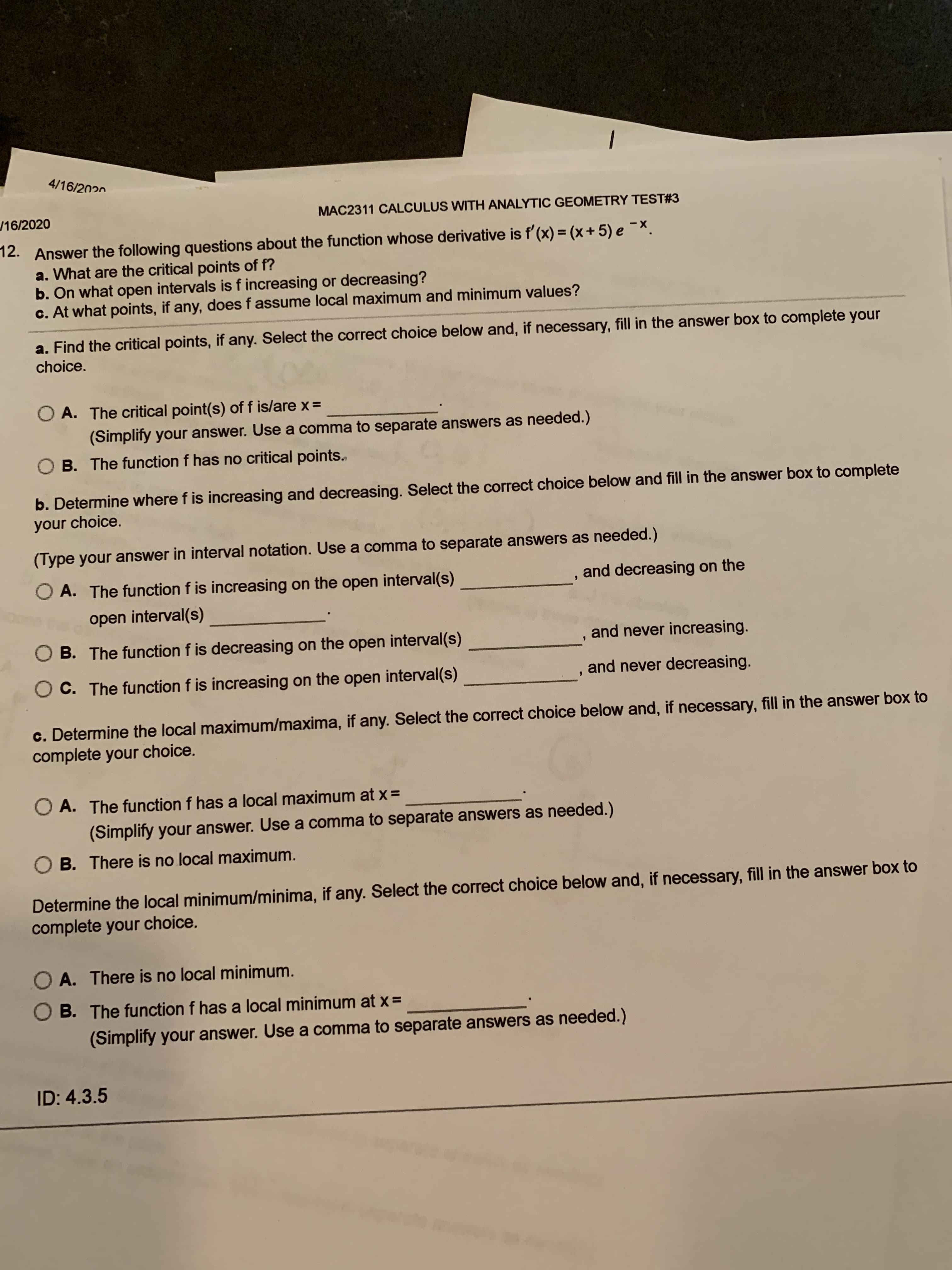4/16/2020 /16/2020 MAC2311 CALCULUS WITH ANALYTIC GEOMETRY TEST#3 12. Answer the following questions about the function whose derivative is f'(x) = (x +5) e ¯×. a. What are the critical points of f? b. On what open intervals is f increasing or decreasing? c. At what points, if any, does f assume local maximum and minimum values? %3D a. Find the critical points, if any. Select the correct choice below and, if necessary, fill in the answer box to complete your choice. O A. The critical point(s) of f is/are x = (Simplify your answer. Use a comma to separate answers as needed.) B. The function f has no critical points. b. Determine where f is increasing and decreasing. Select the correct choice below and fill in the answer box to complete your choice. (Type your answer in interval notation. Use a comma to separate answers as needed.) A. The function f is increasing on the open interval(s) and decreasing on the open interval(s) O B. The function f is decreasing on the open interval(s) and never increasing. O C. The function f is increasing on the open interval(s) and never decreasing. c. Determine the local maximum/maxima, if any. Select the correct choice below and, if necessary, fill in the answer box to complete your choice. O A. The function f has a local maximum at x = (Simplify your answer. Use a comma to separate answers as needed.) O B. There is no local maximum. Determine the local minimum/minima, if any. Select the correct choice below and, if necessary, fill in the answer box to complete your choice. A. There is no local minimum. B. The function f has a local minimum at x= (Simplify your answer. Use a comma to separate answers as needed.) ID: 4.3.5
4/16/2020 /16/2020 MAC2311 CALCULUS WITH ANALYTIC GEOMETRY TEST#3 12. Answer the following questions about the function whose derivative is f'(x) = (x +5) e ¯×. a. What are the critical points of f? b. On what open intervals is f increasing or decreasing? c. At what points, if any, does f assume local maximum and minimum values? %3D a. Find the critical points, if any. Select the correct choice below and, if necessary, fill in the answer box to complete your choice. O A. The critical point(s) of f is/are x = (Simplify your answer. Use a comma to separate answers as needed.) B. The function f has no critical points. b. Determine where f is increasing and decreasing. Select the correct choice below and fill in the answer box to complete your choice. (Type your answer in interval notation. Use a comma to separate answers as needed.) A. The function f is increasing on the open interval(s) and decreasing on the open interval(s) O B. The function f is decreasing on the open interval(s) and never increasing. O C. The function f is increasing on the open interval(s) and never decreasing. c. Determine the local maximum/maxima, if any. Select the correct choice below and, if necessary, fill in the answer box to complete your choice. O A. The function f has a local maximum at x = (Simplify your answer. Use a comma to separate answers as needed.) O B. There is no local maximum. Determine the local minimum/minima, if any. Select the correct choice below and, if necessary, fill in the answer box to complete your choice. A. There is no local minimum. B. The function f has a local minimum at x= (Simplify your answer. Use a comma to separate answers as needed.) ID: 4.3.5
Algebra & Trigonometry with Analytic Geometry
13th Edition
ISBN:9781133382119
Author:Swokowski
Publisher:Swokowski
Chapter7: Analytic Trigonometry
Section7.3: The Addition And Subtraction Formulas
Problem 76E
Related questions
Question
100%

Transcribed Image Text:4/16/2020
/16/2020
MAC2311 CALCULUS WITH ANALYTIC GEOMETRY TEST#3
12. Answer the following questions about the function whose derivative is f'(x) = (x +5) e ¯×.
a. What are the critical points of f?
b. On what open intervals is f increasing or decreasing?
c. At what points, if any, does f assume local maximum and minimum values?
%3D
a. Find the critical points, if any. Select the correct choice below and, if necessary, fill in the answer box to complete your
choice.
O A. The critical point(s) of f is/are x =
(Simplify your answer. Use a comma to separate answers as needed.)
B. The function f has no critical points.
b. Determine where f is increasing and decreasing. Select the correct choice below and fill in the answer box to complete
your choice.
(Type your answer in interval notation. Use a comma to separate answers as needed.)
A. The function f is increasing on the open interval(s)
and decreasing on the
open interval(s)
O B. The function f is decreasing on the open interval(s)
and never increasing.
O C. The function f is increasing on the open interval(s)
and never decreasing.
c. Determine the local maximum/maxima, if any. Select the correct choice below and, if necessary, fill in the answer box to
complete your choice.
O A. The function f has a local maximum at x =
(Simplify your answer. Use a comma to separate answers as needed.)
O B. There is no local maximum.
Determine the local minimum/minima, if any. Select the correct choice below and, if necessary, fill in the answer box to
complete your choice.
A. There is no local minimum.
B. The function f has a local minimum at x=
(Simplify your answer. Use a comma to separate answers as needed.)
ID: 4.3.5
Expert Solution
This question has been solved!
Explore an expertly crafted, step-by-step solution for a thorough understanding of key concepts.
This is a popular solution!
Trending now
This is a popular solution!
Step by step
Solved in 3 steps with 4 images

Recommended textbooks for you

Algebra & Trigonometry with Analytic Geometry
Algebra
ISBN:
9781133382119
Author:
Swokowski
Publisher:
Cengage

Algebra & Trigonometry with Analytic Geometry
Algebra
ISBN:
9781133382119
Author:
Swokowski
Publisher:
Cengage